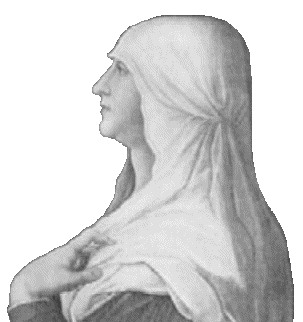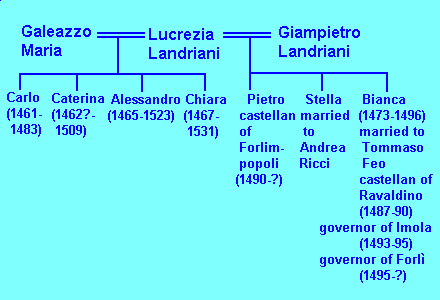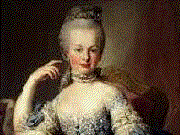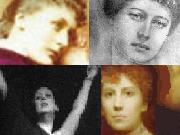Beaverland
Womania
Books on eBay ???
Why not!
Click the picture below!
Enter the BOOKS category and
Find fun and bargains!


Caterina Sforza at 40
Caterina Sforza
(1462-1509)
by Akira Kato
June 18, 2002
A Brief Bio of the Renaissance Virago
One of the most famous (or infamous) Renaissance women, Caterina Sforza came to this world in 1462 as the illegitimate daughter of Galeazzo Maria Sforza, the Duke of Milan, and Lucrezia Landriano, the wife of his courtier.
She grew up to be a legendary beauty and was celebrated for her courage. Together with her first husband, Girolamo Riario, she led the troops in storming one of Rome’s greatest citadels, the Castel Sant’Angelo, in a bid to install their candidate as the Pope when Sixtus IV died in 1484.
In all, she married three times, had 11 children and carried affairs with a number of lovers. In 1499, she was brought down to Rome as prisoner of war when her city, Forli, was seized by Cesare Borgia. She retired to Florence, where she died in 1509, at the age of 46.
The world waiting for the infant Caterina
 |
| Italy during the Renaissance |
 |
The world that waited for Caterina was the
Italy of the early 1460s, and it enjoyed an unprecedented tranquility
brought by the Peace of Lodi in 1454. The on-and-off warring states
forged a league—at first, among Milan, Florence and Naples. It eventually
turned into a general league of all Italian powers.
However, they didn’t throw away their arms. The Italian situation resembled not a state of bliss but an armed truce characterized by constant maneuvering and small-scale fighting in a crisis after crisis.
Meanwhile, the outside powers—particularly France and the Roman Empire—had hardly paid any attention to the Italian affairs simply because they remained tied up either by wars and exhaustion or by internal conflict. Therefore, the Italian states could manage for a quarter of a century to keep in check their traditional animosities and burning expansionist tendencies and to preserve the status quo.
The Peace of Lodi had ended the war in which the Sforza (Caterina’s family) had established themselves as the ruling dynasty in Milan.
- Venice, the aristocratic republic with its far-flung domains and interests in the Levant, was left with its territorial ambitions unfulfilled.
- The Kingdom of Naples, powerful though hampered by a lack of common purpose between the Aragonese king and mighty feudal barons, had to acquiesce in a re-establishment of a powerful Milan.
- The Holy Roman Emperor could not deny the Sforza formal investiture with the imperial possession, Milan.
- Savoy, the Alpine state, readily made peace, since it had long been used to little gain in its battles against neighboring France and Milan.
- The papacy, though maintaining its neutrality, was an Italian power of the first order by its lordship over the Papal States.
- The Medici family, which governed Florence behind a veil of democratic institutions, needed the respite as it entered a period of threat to its supremacy under the aging Cosimo de’Medici, in the 1450s and early 1460s, and his ailing and short-lived successor Piero.
After all, the Sforza had prevailed because of their military prowess, diplomatic skill, and perseverance. They had also benefited from the benevolent neutrality of the papacy. But the money and the friendship of Cosimo de’Medici’s Florence had been the most effective weapon.
Ten years after seizing power, the first Sforza duke of Milan, the aging Francesco, was beset by few grave problems. Milan, released from the hardship of war, benefited from renewed prosperity. A stream of Milanese products, particularly expensive cloth, embroidery, goldsmith wares, and arms poured from the city out across the Alps, the Apennines, and the plain of the Po River.
In addition to all the advantages accruing to the city from its location in an agricultural area of abundant fertility, the urban prosperity produced new wealth and with it new power for Milan. The Milanese had become fond of their new ruler, who exhibited an unaffected simplicity and folksiness.
How did Caterina come to this world?
Galeazzo Maria (Caterina’s father) was born in 1444 as the son of Francesco, the famous condottiere. When the time came to shape Galeazzo Maria’s mind and body, Francesco Sforza could give his son an education befitting a prospective duke. A staff of excellent teachers taught the young man with enthusiasm and sternness. Galeazzo Maria responded by achieving an outstanding mastery of Latin, courtly manners, and outward obedience to his parents.
In 1455 his marital future was settled by a marriage contract with the Gonzaga family, who had been, and still were, of great value as a shield against Venice. Susanna Gonzaga was to be his wife, but she developed a hunchback and her sister Dorotea was substituted in 1457.
In the summer of 1457, the thirteen-year-old Galeazzo Maria began another phase of his education when he visited Ferrara. Two years later his travels became more extensive and led him to Bologna, Florence, Venice, and Mantua, and to a meeting with Pope Pius II. The letters that he wrote to Duke Francesco tell us about the dutiful son who did what was expected of him. They also show how Galeazzo Maria found the freedom and adulation afforded him on such travels entirely to his taste.
Galeazzo grasped little of what mattered in Italian politics, but fully appreciated the trappings of Renaissance courts—the palaces, the gardens, the chase, the dances, and the ladies. While at home he was still treated as an adolescent; the personages at other courts and in other cities saw in him the prospective duke of Milan.
Galeazzo Maria left happier away from home. When not traveling, he tended to prolong his stays at Pavia. The beautiful and expensive park of the old Visconti castle, with its plentiful game, tempted him as much as the distance from Milan. Adolescence added its share of restlessness to Galeazzo Maria’s always erratic personality.
Gradually a circle of young men gathered around Galeazzo to form part of his own establishment. Soon he changed from a dutiful son who wrote pleasant letters to his parents into a brash young fellow who took no advice.
In 1460 Galeazzo Maria traveled within the duchy. Duke Francesco had great misgivings about his oldest son’s aimless assertions of independence and about what he considered the ill-befitting company Galeazzo Maria kept. For two years the son ignored such parental protests and tasted the pleasures of mature life without being bothered by its responsibilities. His world was filled with little but the turbulent companionship of friends, the chase in the green areas of the Po plains, dances, and his first ventures with ladies.
The fire of sexual desire was kindled when Galeazzo Maria met Lucrezia, the wife of his companion in pleasure, Giampietro Landriani. The kind of companionship Galeazzo Maria and Lucrezia offered each other was not hindered by the lack of mental brilliance on Lucrezia’s part, and was significantly enhanced by her beauty, her easily overcome sense of conjugal fidelity, and her husband’s refusal to notice anything.

Giampietro Landriani did not mind being cuckolded by the future duke of Milan, who would hold significant power of patronage. The first result of the young Sforza’s liaison with Lucrezia was a son Carlo (born 1461). Giampietro’s claim to Galeazzo Maria’s gratitude seemed assured when, probably late in 1462, Lucrezia gave birth to a second child whom Galeazzo Maria readily acknowledged as his daughter.
Caterina Sforza entered the world as a lasting memento to the passionate love of a princeling for a beautiful lady. Of course, such sentimental circumstance would not impress the Christian world of propriety and formality. However, illegitimacy was not unusual, if not commonplace, at the time.
The Renaissance men were proud of making their own way. Some churchmen, condottieri, artists and statesmen even boasted that they were born out of wedlock. Illegitimacy didn’t harm the thrusting, self-made men of the Renaissance as most people believed at the time that the fitness of the individual, as well as his worth and capacity, were of more weight than all the laws that prevailed elsewhere in the West.
| Copyright Akira Kato About this author:
|

|


























